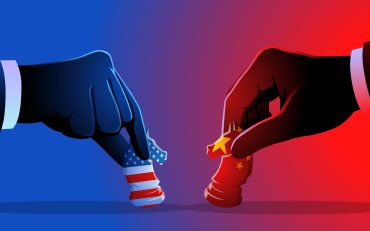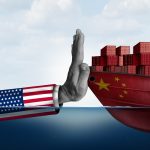

Latest US trade tariffs reshape global supply chains as tech companies navigate rising costs and production disruptions
Key Takeaways
- Tariff escalation reaches 55% on Chinese imports as the Trump administration implements sweeping increases from 30%, while targeting technology sectors with 25% rates on semiconductors and pharmaceuticals.
- US households face $1,200 annual tax increase due to tariff costs passed through to consumers, with peak rates reaching 143.45% on Chinese goods in April 2025.
- Trade negotiations accelerate with August 1 deadline for countries to secure deals with the US or face increased tariff rates, as Trump terminates discussions with Canada over digital services tax disputes.
Introduction
The United States and China are reshaping global trade through an escalating tariff war that increasingly resembles cold war-era proxy conflicts. Rather than engaging in direct bilateral confrontations, both superpowers are leveraging third-country relationships and strategic trade partnerships to pressure each other’s economic interests.
The Trump administration’s latest tariff increases bring rates on Chinese imports to 55%, while China responds with precision strikes on specific US industries. This indirect approach forces allied nations into difficult positions as they navigate between the world’s two largest economies.
Key Developments
Recent negotiations in Geneva and London signal a strategic shift from direct tariff confrontations to complex multilateral engagements. The Trump administration has implemented comprehensive tariff increases, raising rates on Chinese goods from 30% to 55% while China maintains 10% tariffs on US products.
Technology sectors face particular scrutiny, with new 25% tariffs on computer chips, semiconductors, and pharmaceuticals. The administration granted temporary exemptions for electronics including smartphones and related components, though these remain subject to future national security reviews.
Section 232 authority enables expanded tariffs on steel, aluminum, and automobiles, with rates reaching 50% for steel and aluminum globally except for the UK, and 25% for automotive products. The White House extended the initial tariff deadline to August 1, providing temporary relief while intensifying negotiation pressures.
China responds with targeted retaliation, imposing 74.9% anti-dumping tariffs on US exports of polyformaldehyde copolymer, a critical industrial polymer. This precision targeting demonstrates China’s strategy to protect domestic industries while pressuring specific US exporters dependent on Chinese market access.
Market Impact
The tariff escalation creates significant cost pressures across multiple sectors. US households face an average annual tax increase of nearly $1,200 due to passed-through tariff costs, illustrating the domestic economic impact of the trade conflict.
Technology companies confront rising production costs and supply chain disruptions as tariffs on semiconductors and electronics threaten innovation timelines. The volatility peaks with rates reaching 143.45% on Chinese goods in April 2025, creating unprecedented uncertainty for multinational firms operating across US-China supply chains.
Industry reactions reveal widespread concern among US tech firms about long-term viability of cross-border partnerships and manufacturing arrangements. Chinese tech sectors view the conflict as validation for accelerated self-reliance initiatives and domestic innovation investments.
Strategic Insights
The trade conflict accelerates China’s technological independence strategy, driving substantial investments in AI-powered manufacturing ecosystems and domestic semiconductor research. China’s government and private sector are coordinating efforts to reduce dependence on US technology and components.
The United States signals willingness to decouple critical technology supply chains from China, particularly in semiconductors and pharmaceuticals. Both nations are tightening export controls and increasing scrutiny of foreign investment in sensitive technology sectors.
This strategic competition creates a more fragmented global technology landscape, with both superpowers racing toward technological supremacy. The current dynamics suggest a permanent shift rather than temporary trade tensions, fundamentally altering international business relationships.
Expert Opinions and Data
According to The Economist, the emphasis on indirect conflict strategies highlights the intricate dynamics of international trade relationships. Trade analysts note that while tariffs are intended to protect US industry, they have “turbocharged” China’s tech ambitions.
The Court of International Trade permanently enjoined “fentanyl” tariffs and reciprocal tariffs on May 28, though the Court of Appeals for the Federal Circuit issued a stay on June 10, keeping these tariffs in effect pending appeal outcomes.
Business leaders and policymakers in both countries are hedging against further escalation and preparing for a more deeply divided global tech ecosystem. The current situation is viewed as a tactical pause rather than resolution, with both sides preparing for prolonged strategic competition.
By July 9, the US was engaged in discussions with multiple global partners, with completed deals including the UK, China, and Vietnam, while negotiations with India and the EU progress toward the August 1 deadline.
Conclusion
The US-China trade conflict has evolved into a comprehensive economic confrontation that extends far beyond bilateral tariffs. President Trump’s termination of trade discussions with Canada on June 27, 2025, following Canada’s 3% digital services tax implementation, demonstrates the broader global impact of US trade policies.
The conflict fundamentally alters international business relationships and accelerates technological decoupling between the world’s largest economies. Both nations are positioning for long-term strategic competition that will reshape global supply chains and innovation ecosystems for years to come.








